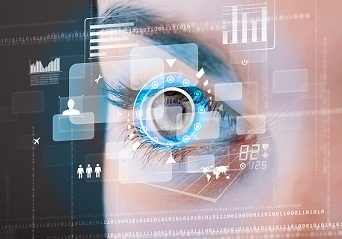We all remember screen-less 3D projection of Princess Leia by R2-D2 in Star Wars. Unfortunately, problem is that, as shown in movie, Princess Leia violates several laws of physics. In real life, a screen-less display needs to reflect light from something invisible, such as water vapour or a see-through mirror, or relays image through some hidden optics as in an "aerial display".

Most people think of this kind of image as a ‘hologram', but that term refers particularly to displays created by a diffraction pattern i.e. a very fine pattern of lines or pixels. If deployed properly, a hologram can give impression of being screen-less since scene can be reconstructed in front of physical display device. But to work well pixels need to be about same size as wavelength of light that we are working with. That limits possible scale. It's not that difficult to make a hologram size of a playing card, but it's currently nearly impossible to make one size of a cinema screen.
A few people, including research group at MIT Media Lab are making holographic video displays. These require significant computational power because they need a ridiculous number of pixels also it requires changing m up to 60 times a second. A relevant recent development is return of 3D, which has been coming back every generation or so since late 1800s. People love 3D, but they generally hates 3D glasses. Thus, recent 3D TVs have failed at home because people do not want to wear glasses every day, but they will still tolerate m on a special occasion, such as a trip to cinema.
Challenge now is to find out a way to make 3D work at home or in office without glasses. A screen-less display might help to make that more attractive. Screen-less also 3D are obviously not synonymous. There are plenty of good 3D displays that are not screen-less also vice versa. But it is interested in 3D screen-less display because those offer such great opportunities.
Goal of much of our work is to get people to stop spending their lives looking at phones also tablets also monitors also instead make real world as responsive, magical also intelligent as screen world. That can involve screen-less displays or it can involve making physical objects intelligent also responsive.
If we can interact with a virtual object by pushing, pulling or turning it, then that's much more appealing than making those same gestures but having results happen on a display across room. Laura Perovich, is building a system called Big Bar Chart. Imagine looking at a bar chart on your phone; it is small also not easy to interact with. Laura is trying to make charts like that physical also human-scale.

With fabric bars, about two metres tall, an actuator that can raise or lower them also a sensor that detects someone pushing or pulling top, you can walk into a room also engage with data in a way you cannot with pixels on a phone. If you lower one of bars, others can move to show overall effect of change. People remember that data visualization in a way that they do not when it is just in Excel.
There is also possibility of using world itself as a screen. Some researchers comprising several colleagues at Media Lab also have begun to explore deploying projectors, which are either worn or placed in environment also provide responsive annotations on physical things. If we can sense what is in front of camera n we can project on to it. For example, if looking at a piece of machinery, instructions for how to disassemble it might be projected onto machinery itself.
A set-up like that becomes more interesting, of course, when one can interact with it. So, when projector knows when actually touching that part of object, it can then change what happens. Like or display technologies, se sorts of things become their most useful also engaging when they are combined with an interaction means also that those will evolve together.